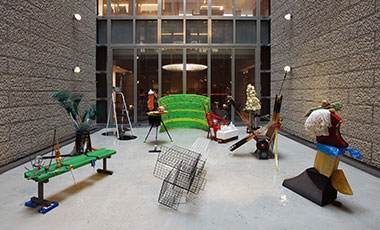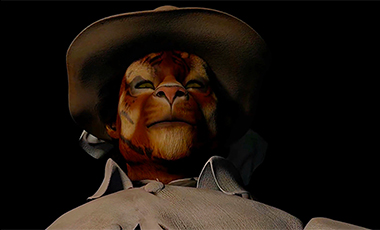Jeong Geum-hyung, winner of the Hermès Foundation Missulsang, is holding a solo exhibition at the Atelier Hermès (Aug. 26–Oct. 23). Titled “Private Collection,” the exhibition displays a peculiar spectrum of personal props, including mannequins, exercise equipment and an excavator. Objects were perched on the white pedestals of traditional museum displays, categorized and allocated accordingly throughout the space, looking like taxidermal samples of her past projects. Yet these objects contain hidden questions concerning the operational processes of desire between artist and viewer, object and subject.
Descending the stairs toward the exhibition hall, I absentmindedly grab a pamphlet printed on B4 paper, and immediately notice my ridiculous mistake. I am holding a menu for the museum café. Putting my embarrassment behind me, I quickly proceed into the exhibition space and pick up another leaflet of the same size. I am pretty sure there will be no more stumbling. For once, the exhibition grounds at Atelier Hermès are completely open, with no makeshift walls whatsoever. Bright fluorescent lights have replaced the usual spotlights, and Jeong Geum-hyung’s “Private Collection” stands on a neat arrangement of pedestals of uniform size. In addition to the mannequins and exercise equipment, there are sex toys, electrical tape and various other objects that all have their own miniature stage. From “7 Ways” (2009) to “Rehab Training” (2015), Jeong’s performances have always left a strong impression on me. “Private Collection,” winner of the 16th Hermès Foundation Missulsang, is sure to rouse powerful memories.
 Installation view of “Jeong Geum-hyung : Private Collection”, Atelier Hermès, 2016, Photo ⓒ NAM Kiyong and Fondation d'entreprise Hermès
Installation view of “Jeong Geum-hyung : Private Collection”, Atelier Hermès, 2016, Photo ⓒ NAM Kiyong and Fondation d'entreprise Hermès
The Voyeuristic Viewpoint of the Exhibited Objects
Yet my ruminations are cut short my attention suddenly diverted from examination of an apparatus of unknowable function by the sound of music. The exhibition features several monitors, but none of them emit any sound. The lackadaisical lounge music is actually coming from the café across the hallway. Music that had probably been otherwise considered an outside distraction now casually and effortlessly trickles into the exhibition space.
“The performance is built on the premise that the audience is going to be physically present. I think that a performance actually starts the moment you start collecting information on it. That’s why I usually think about how such information will influence what people expect from the performance and the way they actually view it.” 1)
As Jeong sees it, the performance or exhibition begins the moment the audience learns of it. Specializing in live performances that always consider the audience’s presence, Jeong surely picked up on all the sensory clues that this exhibition hall offers. The music from the café was an intentional addition. It shatters the silence of the performance from a distance. All objects on display face the viewer directly (the mannequin included), but viewing them from the rear reveals a different landscape. The exhibition hall’s glass wall reveals a courtyard beyond which café-goers sit and chat. Two dolls made from rubber tubing hang from the ceiling above the object’s pedestals, which draws the eyes to the center of the courtyard. Male dolls, one with chest hair and the other with a penis attached face the café as well.
 Jeong Geum-hyung, ‘7 Ways’, 2008_2015, Performance, 75mins
Jeong Geum-hyung, ‘7 Ways’, 2008_2015, Performance, 75mins
The introduction to the exhibition is highly provocative, claiming that it offers “personalized” moments of presumption, where “objects converted into art” stimulate the individual imagination and reveal one’s greed, stealthily yet aggressively, within a pure-white “vacuum” cut off from the outside world, where the artist is absent. 2) Yet this show-window gallery is not a vacuum where visitors can sink into their desires. It embraces and elicits a voyeuristic intrusion by which the visitor is viewed in a different light. Furthermore, as with Jeong's other performances, her objects do not simply stay content with being the passive objects of the subject’s desire. The two dolls of rubber tubing are more than just objects for the viewers’ greed; they, too, are active agents that stare outside the window, suggestive of the eyes of those on the outside watching the visitors inside the exhibition.
The distinctiveness of the region is worth special mention in Asia. Because the location of 3 countries is close to the last ceasefire area of the world, any political and social crisis brings the need of art and culture, as well as the movement to suggest them as one community. This is followed by the regular exchanges between Asian countries in 1990s and the advent of “the time of Asian biennales,” as well as the diplomatic success of China-Japan-South Korea trilateral summit (1999). The curation of The Subtle Triangle is started with this trend of the time, but intend to avoid the competition between the nations and to face the present as the result of the past, instead of presenting the beautiful and hopeful future. Also, the curation focused on questioning how the series of past history can consist the present and show us the future.
The Audience's Desire as a Consumer
I have previously described how Jeong has transmogrified “objectification of the body,” the doctrine of performance of past generations, into the death of the artist or the even the death of subjecthood, in a “transference of the position of orgasm-craving subject to the object, or though an agent of desire, as passive.” Pointing out how Jeong became a certified operator of hydraulic excavators for her work, I indicated that she was “demonstrating her passive subjecthood, the impossibility of her ever being fully a sexually desiring subject, and engaging as a passive subject in ‘learning’ by which she might attain such impossible desires.”3) Her “learning” continues in “Private Collection.” “Printed materials,” mainly medical textbooks and exam papers from engineering courses, lay on one side of the exhibition, and the six monitors that hang from the ceiling show video “Tutorial” for the objects on the pedestals. (For the reader's information, Jeong does not adhere to conventional notational systems, and simply divides her archive into five categories: 1. Commercial Clips (purchase considered); 2. Commercial Clips (purchase completed); 3. Printed Materials; 4. Objects; 5. Tutorial)
 Installation view of “Jeong Geum-hyung: Private Collection”(detail), 2016, Atelier Hermès, Photo ⓒ NAM Kiyong and Fondation d'entreprise Hermès
Installation view of “Jeong Geum-hyung: Private Collection”(detail), 2016, Atelier Hermès, Photo ⓒ NAM Kiyong and Fondation d'entreprise Hermès
Yet this exhibition adds a new context to the artist’s “learning.” First off, the “Printed materials” is inaccessible to viewers, guarded by an attendant, which encloses the artist's references as precious objects and thereby separates the perspectives of artist and viewer. No matter how strange or unfamiliar it seems, Jeong’s collection is still a ready-made. But as a private collection, it is a ready-made that escapes the tradition of having the viewer question an artwork's aura, instead aggressively utilizing the artist's aura. In this case, the viewer can never become a user who substitutes for the artist's absence. The objects are merely the artist's aura — in short, they only appear under her direction.
Her “Turorial,” on the other hand, is a device that appears to thoroughly dismantle the performance's aura. In “Rehab Training,” –with an original running time of 160 minutes, Jeong employed a long and concentrated rhythm that she thoroughly exhausted. For “Private Collection,” she uses the video footage from “Rehab Training” but edits them into short, ad-style clips and plays them on repeat across six monitors. The tutorial for the objects are contained in two real-life advertisements, revealing the artist's urge to purchase or her completed transactions and bringing to mind the image of the artist herself as a consumer. By employing commercial clips, her “Tutorial” directly compares her objects to products for sale. Thus, the viewer of the “Tutorial” is more a consumer than a learner. This effect is augmented by Jeong’s strategic exclusion of her “printed materials,” making the viewer more than just a user of an object but someone who hungers for the aura of a commercial product.
 Jeong Geum-hyung, ‘Rehab Training’, 2015, Performance, 160mins, Photo: MINGU JEONG
Jeong Geum-hyung, ‘Rehab Training’, 2015, Performance, 160mins, Photo: MINGU JEONG
Can the audience become the subject of desire that replaces the artist? What are the audience's desires? Can they be satisfied? Will this exhibition inspire viewers to long for the artist’s objects as consumers? If such greed does arise, is it the active desire of the viewer cum subject, or a passive desire that is controlled by the artist’s direction? Assigned to roles as (potential) consumers, are the viewers “participating” in the art and exhibition? People in the café across the courtyard may be able to participate by simply ordering a cup of coffee, but what on earth does their involvement mean? Can the artist’s “instruction manual” become a practical guide that stimulates commercial consumption? Such an instructional manual is likely an adherence to the scattered rhythms of advertising rather than an active or free agent, failing to bloat the fantasy of control through its implications of death and passivity. With that in mind, perhaps “Private Collection” is not just a taxidermal collection of Jeong's past projects, but rather a search for a unified exhibition method. Whereas her performances took place under the pretext of spatial and temporal anonymity, it's interesting that in this exhibition, a kind of site specificity can ultimately be attained.
1) Interview with Jeong Geum-hyung by Ahn Soyeon
2) Kim Yun-kyoung, 『Atelier Hermès Review #5, Private Collection: Jeong Geumhyung's Solo Exhibition』, p. 11.
3) Seoul Museum of Art(SeMA), 『2015 SeMA- SeMA-HANA Art Criticism Award, Talks on Contemporary Art Criticism in Korea』(2015. 12), pp. 73-74; Kim Junghyun’s personal blog

Kim Junghyun / art critic/independent curator
KIM JUNG HYUN is an art critic and independent curator. Kim writes and curates exhibitions with an interest in the forms and structures by which criticism and creation intervene in one another’s realms. She was awarded 2015 SeMA HANA Art Criticism Award and selected as a visual art curator for AYAF by the Arts Council Korea. She curated 《Walking Log》(co-work), and 《Change Nothing》(Seoul Art Space Mullae, 2016), 《Pirate Edition》(SeMA Nanji Residency, 2017) and 《Yeon Mal Yeon Si》(Insa Art Space, 2015), etc.


